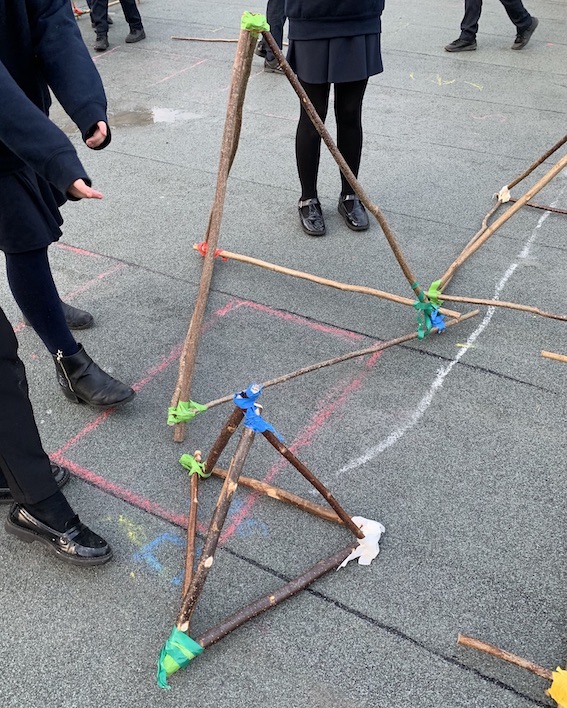Last week I was visiting a school where the P5-7 class had just begun to look at scale. This is a super topic that lends itself naturally to outdoor work. With the Scottish experiences and outcomes, there is no mention of scale within Level 1 in the Maths or Numeracy curriculum areas, however, common sense suggests that a little bit of previous work can pay dividends and links nicely to art and geography activities.
A few months ago, I bought some sticks from the Forest School Company, Muddy Faces. This may sound shocking. After all, sticks are there to be picked up from under a tree and played with. However, my big bag of sticks was being well-used at a local primary school and I didn’t want to remove these. Furthermore I noticed that the sticks I bought came in specific pre-cut lengths, unlike picked-up sticks.

The sticks are cut to approximately 60cm and 30cm respectively or 1ft and 2ft lengths. So this is ideal for some initial explorations into simple scale. As you can see, a square can be made and doubled in size…
Children can make different shapes, any shape, using a small set of sticks and then the large. Or the other way round…

These shapes can be carefully and accurately copied onto squared paper, with the children deciding the scale, e.g. 1cm on paper = one 30cm stick, 2cm on paper = one 60cm stick. Once simple shapes have been created, they can be enlarged with more sticks like this…
Or this…
And this…
The concept of repetition in pattern work is geometrically interesting. There is the potential to increase or decrease any shape infinitely based upon each new term being generated by the rule of the repetitions or replications.
Letting children decide a rule of replication can lead to all sorts of interesting patterns. For older children, the recurrence can be examined by looking at the perimeter and area of each square and seeing how this is affected by the pattern, e.g.
Perimeter = 4m, Area = 1 sq m
Perimeter = 8m, Area = 4 sq m
Perimeter = 12m, Area = 9 sq m
Perimeter = 16m, Area = 16 sq m
Perimeter = 20m, Area = 25 sq m
This can be plotted on graph paper and can help lead to interesting mathematical discussions.

One of the reasons, I think this works well is the speed and ease at which patterns can be created. There’s no mess from chalk, no rubbing out of pencil lines, no laborious sewing of patches, and so children can easily play with the designs. As you can see, I had a lot of fun in my back garden…
Taking a pattern and creating patterns within and beyond patterns…
The only limit is the space and number of sticks available…
My supply of 72 small and 72 large sticks seems to be working well with classes of up to 25 children. I think a few more might be needed with larger classes. It’s great for cooperative group work.
And for devising puzzles and challenges…
I do believe every school needs sticks!
Update, November 2020:
Scale can also be applied as a 3D concept. Below is an example of of a tetrahedron being created by a group of children using 1-metre sticks and 50cm sticks. It really gives children an idea of how much smaller or larger an object becomes if the length of sticks are doubled or halved.





















Juliet- I love this! It is amazing what children can do and learn through exploration with every day natural materials. I remember when I worked in a center and they removed all of the sticks, I’m saddened by the loss of opportunity when we remove them!
I really love what you are doing here! It sort of relates to my school project which is coming up with a school schedule that exemplifies certain students learning abilities. I am creating a schedule for kids who learn better doing hands on activities. It would be great if you could comment on the schedules that I come up with and help me critique them!
http://skylerhuffmanblog.blogspot.com/
Thank You